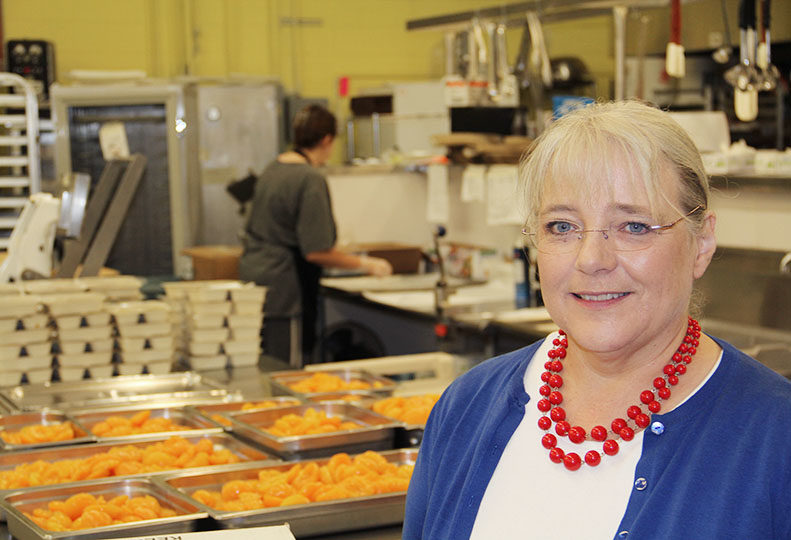
Home » Greater Spokane County Meals On Wheels looks to expand
Greater Spokane County Meals On Wheels looks to expand
Agency on pace to serve 273,000 meals this year

September 24, 2015
The executive director for Greater Spokane County Meals on Wheels says the organization wants to establish three more meal sites within the county.
Pam Almeida is exploring how to get money for new meal sites in Airway Heights, on Spokane’s North Side, and at the Southside Senior Center, at 3151 E. 27th, on the South Hill. Meals on Wheels currently operates 13 meal sites across Spokane County.
“There is a need for three more, however, Airway Heights’ growth has seen a real increase in homebound seniors needing to be fed,” Almeida says.
Baby boomers entering their senior years have generated a rising increase in users. Meals on Wheels provides both on-site and delivered hot meals to seniors during the weekdays, Almeida says.
In 2011, Meals on Wheels served a total of 230,000 meals, 298,000 in 2012, 246,000 in 2013, 294,000 in 2014 and is on pace to serve 273,000 this year.
“It still continues to floor me,” Almeida says. “And for more than a quarter of those served—27 percent—that is their only meal of the day.”
Greater Spokane County Meals on Wheels, formerly Valley Meals on Wheels, mostly served seniors in the greater Spokane Valley area prior to 2011. It now serves all of the Valley as well as Deer Park, Cheney, parts of the city of Spokane, and some unincorporated areas of southern Spokane County, Almeida says.
Based at 12101 E. Sprague, in Spokane Valley, Meals on Wheels has 30 staffers, 19 of whom are full-time employees. The 13 meal sites throughout the county are operated by part timers. The majority of help, however, comes from a volunteer base of about 350. Almeida says the nonprofit needs more.
At least one north Spokane church, and a city-run facility in Airway Heights may be available for the new meal sites, Almeida says. The immediate challenge is funding, as it takes approximately $10,000 at each location to pay a part-time staffer, she says.
Food is prepared at the Meals on Wheels kitchen at 218 N. Crestline and then driven to the meal locations around the county or delivered to the customer’s home.
Qualifying residents must be 60, essentially homebound, and have difficulty preparing their own meals. Those under 60 need a physician’s recommendation for home delivered meals. Meals on Wheels can deliver seven frozen meals per week to a single customer, Almeida says.
Meal costs are based on a sliding fee scale. The cost of meals for a month is 5 percent of a person’s net monthly income. Each meal provides one-third of the recommended daily nutrition requirement and has no added salt. Additional liquid nutrition is also offered in the form of Ensure, Ensure Plus, and Glucerna.
Ensure and Ensure Plus are $17.50 for a case of 24, and Glucerna is $31 for a case of 24. A physician’s recommendation is required to receive liquid nutrition.
Meals on Wheels’ 2015 budget is $1.7 million. At the beginning of the year, Aging and Long Term Care of Eastern Washington awarded Meals on Wheels a government-funded contract of $852,000 for 2015, which is 52 percent of Meals on Wheels’ budget. The appropriation was the first in a four-year contract, Almeida says.
Aging and Long Term Care also participates in overseeing the disbursement and delivery of food to the county’s seniors. It is one of 13 area agencies that contract with the Washington state Department of Social and Health Services to provide in-home care and community-based services statewide.
Almeida says clients paying on the sliding-fee scale will generate $232,000, 14 percent of the nonprofit’s budget, in 2015. The budget’s remaining 34 percent, $616,000, comes from an assortment of grants, donations, and fundraisers.
“Eighty-three percent of our expenses are directly program related, with 17 percent going for general admin and fundraising,” she says.
Last month, Meals on Wheels was awarded a $10,000 grant from the National Association of Nutrition and Aging Services Program based in Washington, D.C. The grant was one of nine distributed to cities across the country. Almeida says that money will be used in conjunction with Washington State University to develop a comprehensive nutrition assessment for senior citizens in the area.
The goal of the assessment will be to determine if the Affordable Care Act can in some way enhance senior nutrition programs across the country.
“This is more social entrepreneurship. There have to be better ways to increase funding for seniors other than always asking the immediate community for money,” she says.
By more effectively tying nutrition to healthcare through existing research, communities across the country have the potential to strengthen their case for more federal dollars for improved nutritional foods, and greater portions, for elderly residents, she says.
“It’s time for real substantive dollars to be put there,” Almeida says. “If people have to choose between medication and food, they’ll choose food. You have to eat healthy to be healthy.”
Special Report
Related Articles



